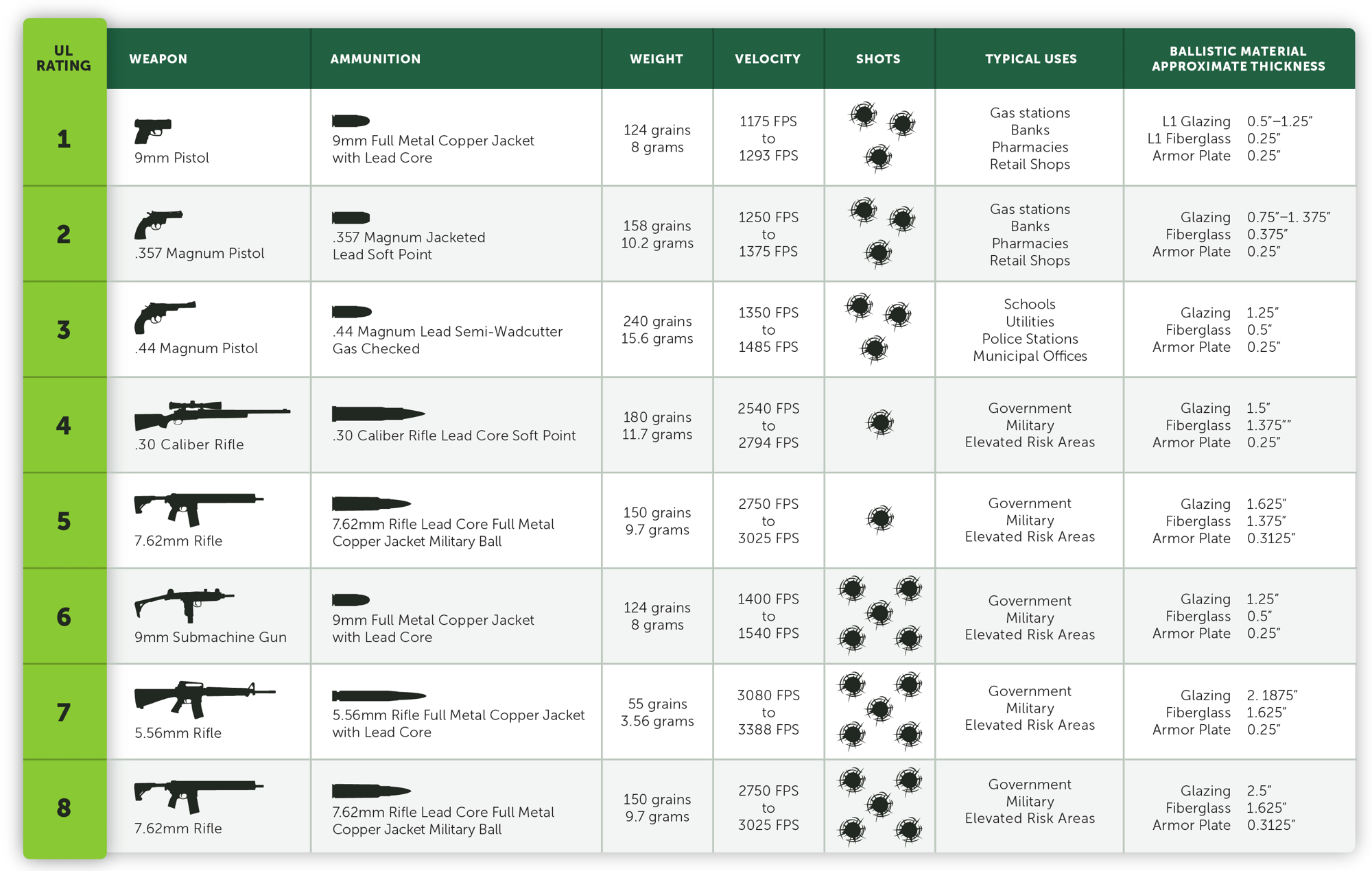Bulletproof and Ballistic Glass
End-to-end consulting, design, fabrication, and installation for your custom bulletproof windows, doors, and more.
What is Bulletproof Glass?
Bullet-resistant glass, commonly called bulletproof glass or ballistic glass, is made of transparent materials specially designed to resist the penetration of bullets. The most common types of bulletproof glass are fabricated using acrylic, polycarbonate, actual glass, or laminated layers thereof such as glass-clad polycarbonate.
Unlike traditional glass, ballistically rated glass is typically the center point of more complex bullet-resistant barrier systems like a teller line at a bank, school entrance, convenience store checkouts, or bullet-resistant windows in government buildings. Understanding the unique qualities of each type of bullet-resistant glazing is essential to choosing the right product for your ballistically protected physical barrier system.
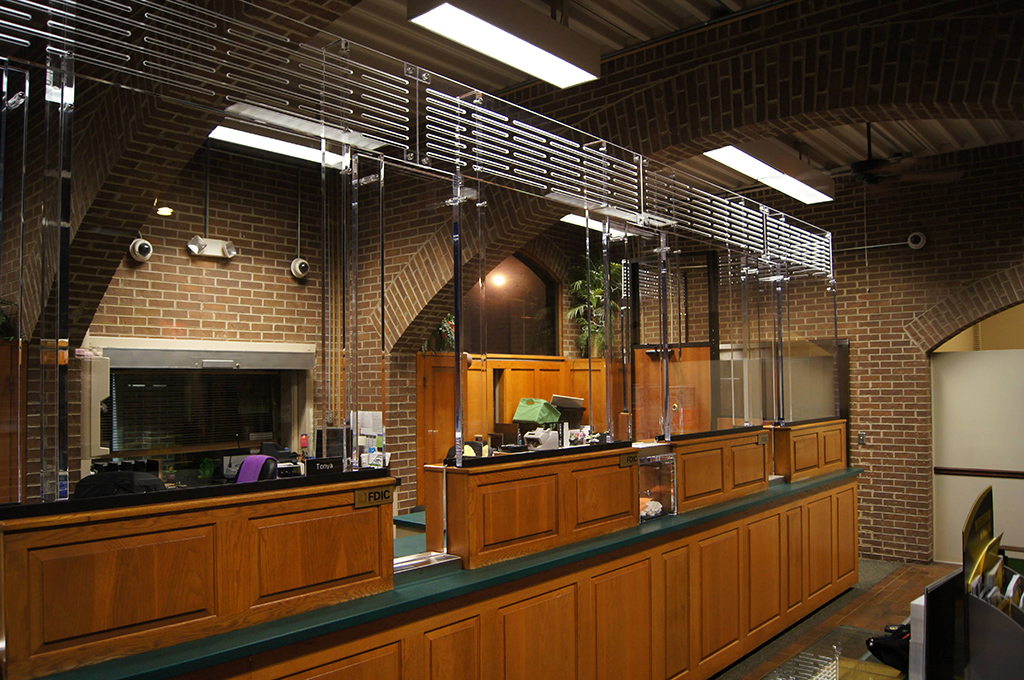
The Four Types of Bulletproof Glass
Choosing the right type of bulletproof glass for your project will depend on specific risk factors, the materials appropriate to the threat level, and the functionality and aesthetics of the building. The most common interior types of bullet-resistant glazing actually use monolithic acrylic or layers of polycarbonate. By carefully selecting which materials to layer in what way, TSS can make bullet-resistant glazings that accommodate a wide range of configurations and safety levels.
The four most common forms of bullet-resistant glazings are acrylic, polycarbonate, glass-clad polycarbonate, and insulated glass.

Acrylic Bullet-Resistant Glazing
Bullet-resistant glass, commonly called bulletproof glass or ballistic glass, is made of transparent materials specially designed to resist the penetration of bullets. The most common types of bulletproof glass are fabricated using acrylic, polycarbonate, actual glass, or laminated layers thereof such as glass-clad polycarbonate.
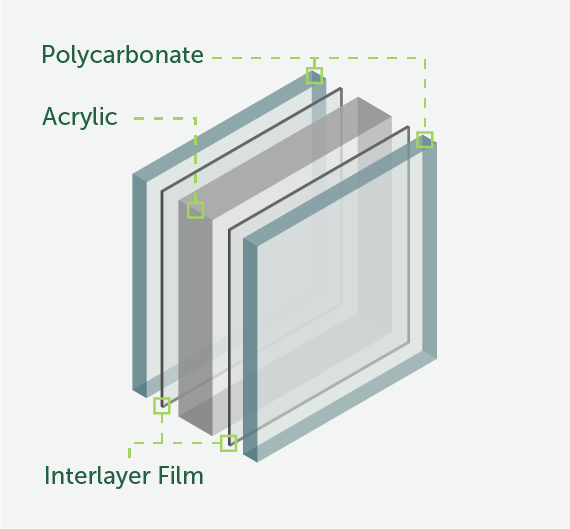
Polycarbonate & Laminated Polycarbonate Glazing
Ballistic polycarbonate is also a popular choice for bulletproof barriers, as it can be less thick yet deliver higher impact protection than acrylic panels. This impact protection applies not only to bullets but also to forced-entry attacks and severe weather events such as hurricanes.
Polycarbonate ballistic glass is recommended for indoor applications and is available in UL levels 1-3.
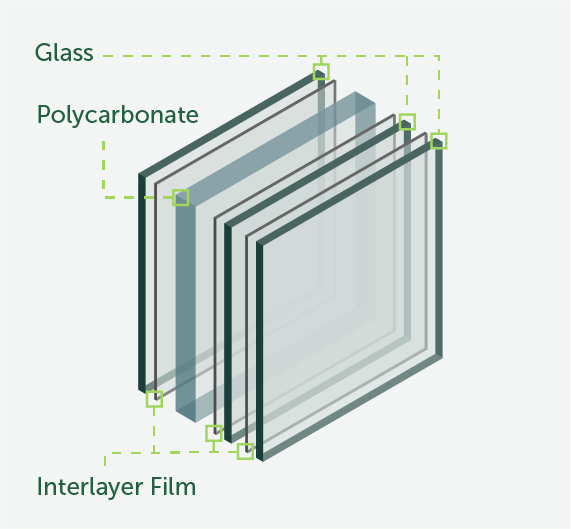
Glass-Clad Polycarbonate Glazing
Glass-clad polycarbonate (GCP) is a high-performance glazing made with multiple layers of glass and polycarbonate. Using polycarbonate layers in the construction yields superior ballistic protection than old school glass-only panels.
Glass-clad polycarbonate ballistic glass is recommended for interior and exterior applications and is available in UL levels 1-8.
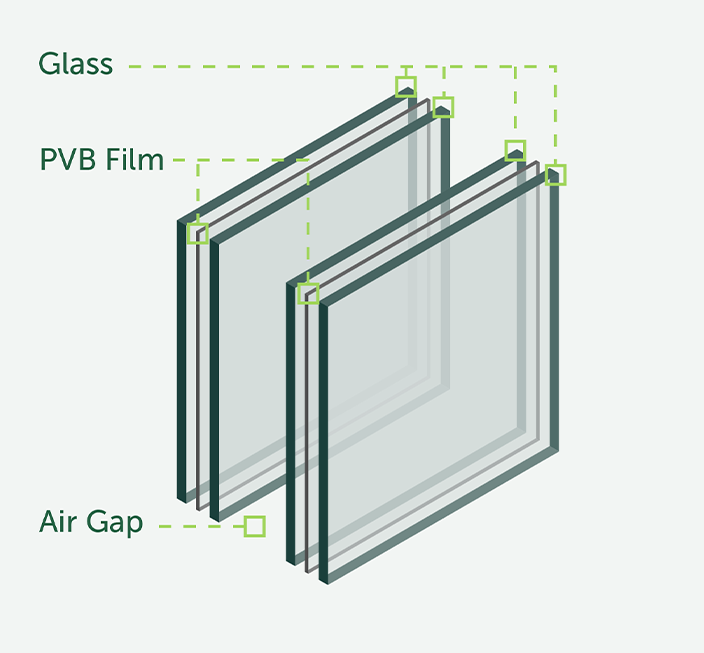
Insulated Glass
A whole new generation of bulletproof glass is now available from Total Security Solutions. The TSS DEFENDER Ballistic Insulated Glass product line meets energy requirements, offers ballistic and forced-entry resistance, and is a cost-effective option for ballistically protecting your building’s perimeter.
Ballistic insulated glass is recommended for exterior applications and is available in UL levels 1-8.
Product Comparison Chart
Acrylic |
Polycarbonate |
Glass-Clad Polycarbonate |
Insulated Glass |
|
|---|---|---|---|---|
| Applications | Interior Windows and Doors | Interior Windows and Doors | Interior or Exterior Windows and Doors | Exterior Windows and Doors |
| Thickness | 1 1/4” to 1 3/8” | 3/4” to 1 1/4” | 13/16” to 2 1/2” | 15/16” to 1 1/4” |
| Protection Level |

|
|
|
|
| Forced Entry Protection | No | Yes | Yes | Yes |
| Light Transmission | > 90% | 75-85% | 60-85% | 60-80% |
| Weatherability | Sensitive to exposure and solvents. Abrasion-resistant coating available. |
Sensitive to exposure and solvents. Abrasion-resistant coating available. |
Heightened resistance to weathering and solvent damage. | Heightened resistance to weathering and solvent damage. |
Need help finding the right solution for your project?
We offer complete security solutions custom-designed for your building, from secure entryways, barrier systems, and safe rooms to bulletproof windows, walls and counters. Get free advice from our ballistic experts.
BALLISTIC GLASS EDUCATION
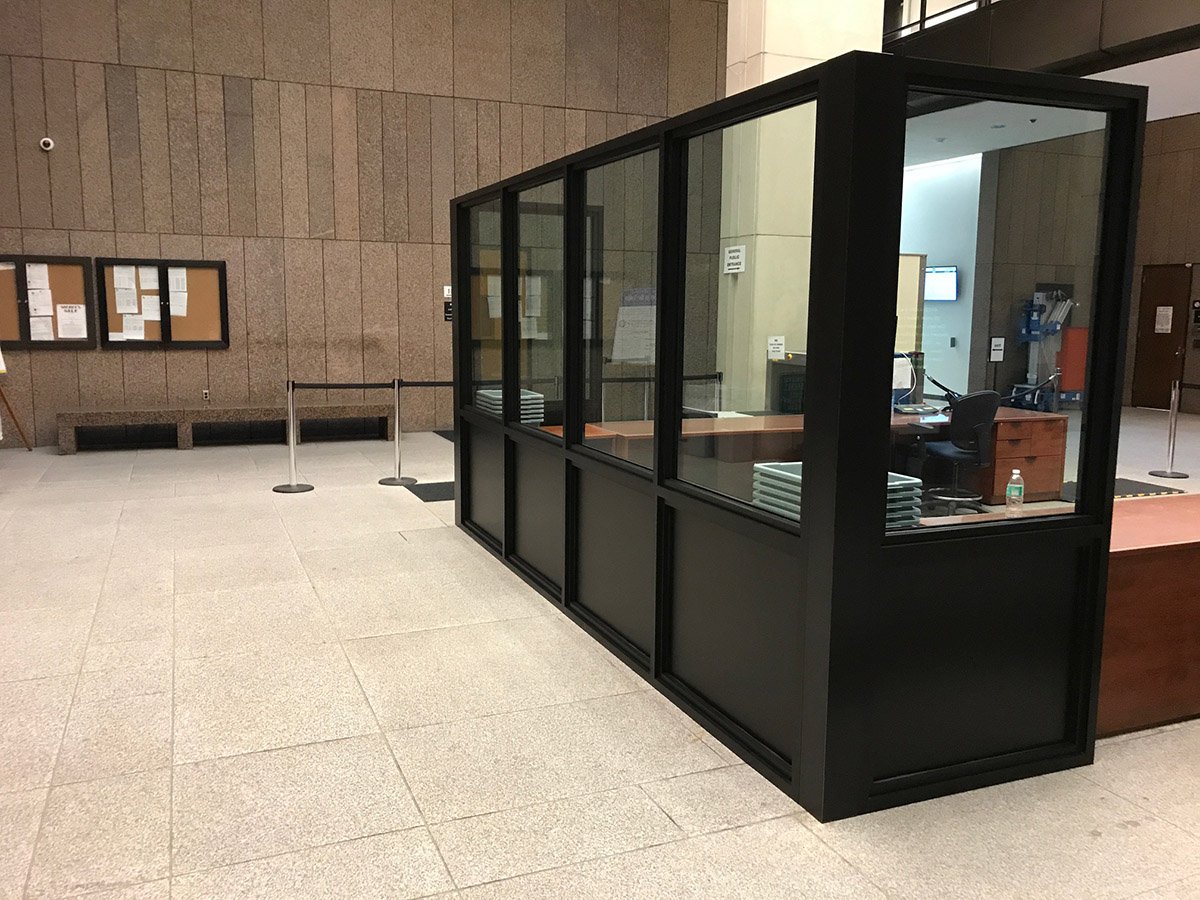
Ballistic Glass vs Ballistic Glazing: Is There a Difference?
Ballistic glazing, or simply glazing, is a glass industry term that encompasses all types of transparent ballistic panels. As previously mentioned, bulletproof glazing may be made up of acrylic, polycarbonate, glass, or a combination such as glass-clad polycarbonate.
Confused? Don’t worry, whether you call it bulletproof glass, bullet-resistant glazing, or ballistic glass—people will understand you’re speaking about transparent panels that stop bullets.
Ballistic Glass vs Bulletproof Glass vs Bullet-Resistant Glass: Which Term is Correct?
Simply put, the proper industry term is bullet-resistant glass, but the most commonly used term is bulletproof glass. Ballistics, as defined in the Collins dictionary, is actually “the study of the movement of objects that are shot or thrown through the air, such as bullets fired from a gun.” In the real world, all three terms are used interchangeably.
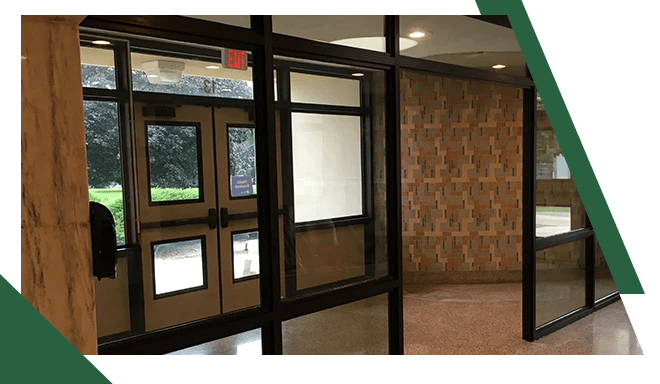
Understanding UL 752 Rating System for Bullet-Resistant Windows, Doors & More
To be considered bullet-resistant, glazing designed for use in a bulletproof system goes through a series of tests to evaluate its ability to stop various ballistic attacks. The Underwriters Laboratories (UL) publishes the UL 752 Standard for Safety Bullet-Resisting Equipment—one the longest-standing and most nuanced rating systems. The 10 bullet-resistance levels of UL 752 are considered the “gold standard” in the industry and describe grades of ballistic resistance encompassing weapon calibers ranging from a 9mm handgun up to a .50 caliber rifle.
UL-rated materials are favored (or, in many cases, mandatory) in building construction. All TSS ballistic products have been tested by independent, third-party testing labs to ensure they perform up to, and typically beyond, the UL 752 standard.
Choosing the Right Product, From Bulletproof Windows & Doors to Forced-Entry Protection
When it comes to bulletproof glass, there are unlimited customization options. From level of protection to tinting to spall, it’s important to know what you need to make the right choice for your situation. We know how complex (and overwhelming) the sheer number of options can be, which is why we created the Ballistic Glazing Solutions Guide. This free, comprehensive ebook provides no-nonsense information and tips to help you identify the right bulletproof glass, whether you’re working on your first bulletproofing project or your fiftieth.
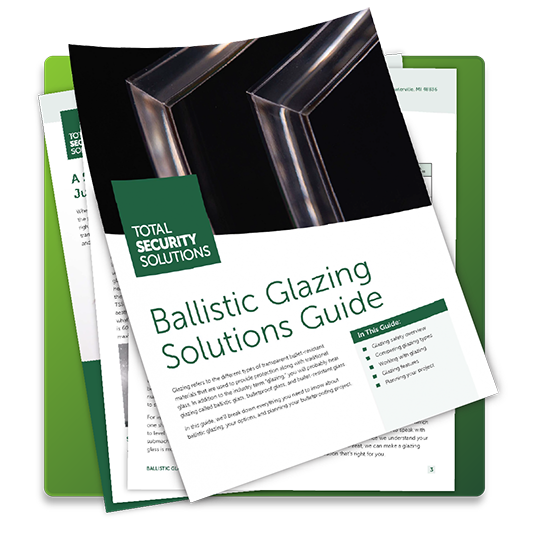
How Much Does Bulletproof Glass Cost?
For the average comprehensive bulletproof security system, you may pay anywhere from $15,000 to $25,000. The cost of a ballistic system involves much more than the simple square footage of bullet-resistant glazing, and the estimates above may be higher or lower based on your project’s details.
When considering your budget for a ballistic barrier project, remember that you’ll need to factor in the costs for each additional component of a complete system (like doors, wall panes, framing, and accessories). Your final quote will also include costs allocated for design, manufacturing, packaging, freight, and installation.
By offering custom-designed solutions for every unique situation and project, TSS makes sure you only pay for the products and services you need. The best way to determine the cost of your bulletproof system is to speak with a TSS ballistic expert!
BULLETPROOF WINDOWS OR SECURITY WINDOW FILM: WHICH STOPS BULLETS?
Security window film is often proposed as a less expensive, quick “bulletproof” solution for businesses interested in upgrading their security on a smaller budget. However, security window film is not a ballistically-rated material and will not stop bullets.
Your threat level and unique security concerns should always determine what security solutions are right for your business, office, or facility. We created a free guide to help you understand the differences between bullet-resistant glass and security window film and enable you to make the most informed decisions about your building’s physical security.
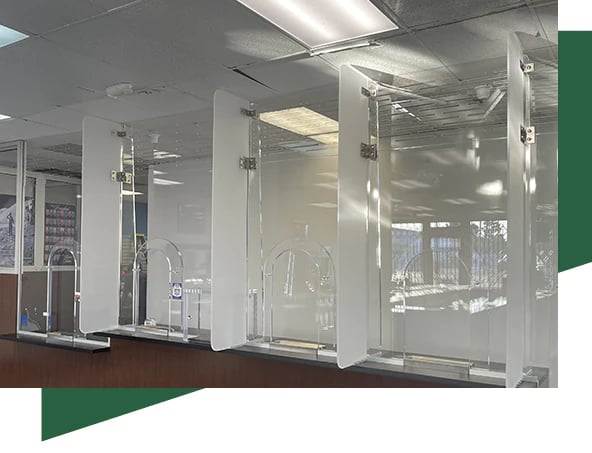
Frequently Asked Questions About Bulletproof Glass
Can bulletproof glass break?
Yes. Bulletproof glass is incredibly strong, but not indestructible. It’s engineered to absorb ballistic energy and hold together under attack, even when cracked or shattered.
Like any physical barrier, it can fail under repeated impact, especially if multiple rounds hit the same spot or if the framing is weak. But its purpose isn’t to be unbreakable; it’s to buy time.
Whether it’s UL 752 Level 1 protection for handguns or Level 8 for high-powered rifles, ballistic glass is designed to slow intruders long enough for people to escape and authorities to respond.
What is bulletproof glass made of?
Bulletproof glass is made by layering different materials—primarily acrylic, polycarbonate, glass, and specialized interlayers—depending on the desired level of protection. There are four main types:
-
Monolithic acrylic (a solid acrylic sheet, common for Level 1–2 protection)
-
Laminated polycarbonate (multiple layers of polycarbonate and acrylic bonded with TPU interlayers)
-
Glass-clad polycarbonate (glass layers fused with polycarbonate for Levels 1–8)
-
Insulated glass units (IGUs), which combine ballistic performance with energy efficiency and may include an air or argon-filled gap
These combinations work together to slow, catch, and disperse a bullet’s energy, making it harder to penetrate while maintaining visibility and structural integrity.
How strong is the strongest bulletproof glass?
The strongest bulletproof glass commercially available is rated UL 752 Level 10, capable of stopping a single .50 caliber rifle round. This level is extremely rare in real-world use due to its weight, cost, and thickness.
The most common high-strength option used in commercial and institutional buildings is UL 752 Level 8, which can stop five shots from a 7.62mm rifle at close range. This glass, typically made of glass-clad polycarbonate, is up to 2.5 inches thick and weighs over 26 pounds per square foot, requiring special structural support.
While many organizations inquire about Level 8 protection, most only need Levels 1–3 based on their actual threats—usually handguns. That’s why a custom threat assessment is critical.
Is bulletproof glass a good insulator?
Standard bulletproof glass alone does not provide effective thermal insulation. For energy efficiency and indoor comfort, bulletproof insulated glass units (IGUs) are the better choice.
TSS offers UL-rated IGUs that combine ballistic protection with an air or gas-filled thermal break—ideal for exterior windows in commercial, institutional, or retrofit applications. Our Defender and GCP product lines offer protection up to UL Level 5, with options like Low-E coatings, tints, and forced-entry resistance to meet security, climate, and performance goals.
If insulation matters to your project, we’ll help you select the right ballistic IGU for your needs.
Is bulletproof glass beneficial in homes?
Bulletproof glass can offer meaningful protection in homes, especially in panic rooms or residences facing elevated security risks. It provides peace of mind and can help delay intruders long enough for authorities to respond.
Total Security Solutions focuses exclusively on commercial, industrial, and institutional environments where systems are more complex and installation requires specialized engineering. From banks to schools and government buildings, our expertise lies in integrated, code-compliant ballistic systems.
If you're exploring ballistic protection for your home, we recommend reaching out to a provider that specializes in residential security solutions.
Why Choose TSS as Your Custom Security Solutions Provider
When you choose TSS, you’re choosing a company with decades of experience consulting, designing, fabricating, and installing ballistic barriers around the country. We have worked with countless industries and specialize in adding Safety + Aesthetics to any space. If you’re looking for support for your bulletproofing project, TSS is your end-to-end partner.
Consulting
If you know you need to add a layer of bulletproof material to your space, but you don’t know where to start, call us. Our security experts can help you make a practical plan for increasing your security.
Custom Design
Bulletproof barriers should fit seamlessly into your space. Our design capabilities make sure you get the perfect fit every time—even when you need to accommodate historical millwork, create a mantrap, or some other custom considerations.
In-House Fabrication
All of our products are fabricated in-house by expert craftsmen. Nothing is off the shelf—ever. This results in a superior product that’s perfect for you and your needs.
Expert Installation
Once fabrication is complete, our in-house team of installers are ready to travel to your location to ensure the product is installed correctly. Plus, we ensure your business’s continuity by completing installations overnight.
We Engineer Confidence

Unlike competitors who sell off-the-shelf products, we design, build, deliver and install custom bullet-resistant barrier systems that are right the first time. Our Proven Process ensures your project is tailored to your exact specifications, manufactured in-house for quality control, and often installed in a single day. That means no delays, no costly change orders, and no workarounds on-site. It’s why architects, contractors, and security leaders have trusted us to protect more than 30,000 buildings in over two decades.
